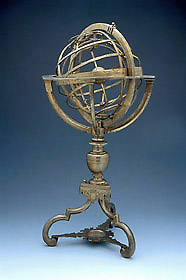
 |
| Catalogue |
 |
 Armillary Sphere The legs rise to a triangular stage, two sides decorated with a blank shield surmounted by a crown, the third with arms identified as those of 'CAMILLVS GONZAGO COMES NOVELLARVS'. Above this a turned column rises to four quadrant supports for the horizon ring, with date, zodiac (first point of Aries at 21 March) and degree scales. The months are named in Latin and divided to single days, the zodiac signs are marked by names and symbols and divided to degrees, the degree scale is divided 0 to 90 to 0 to 90 to 0 from the meridian ring, divided to 10, subdivided to 5 and to 1, numbered by 10. Four cardinal points are named on the rim. The underside of the horizon ring is signed: 'CORNELIO VINCHX FIAM, DA MVERS? F?CEB, NEAPOLI Anno 1601'. The meridian ring, adjustable for latitude, has a degree scale for declination, 0 to 90 to 0 to 90 to 0, beginning at the pole, divided to 10, subdivided to 5 and to 1, numbered by 5. The ring has a sliding cursor, with a clamp. The polar axis supports a sphere composed of four meridian rings, equator, tropics, arctic and antarctic circles and an ecliptic band. The arctic circle is divided for hours, 1 to 12 twice, and is fixed, while above this another 24-hour circle is moveable, so as to adjust for Babylonian or Italian hours. There is a pivoted, curved index for time. The ecliptic band is marked with the names, symbols and representations of the zodiacal signs, each with a scale of 30 degrees, divided to 10, subdivided to 5 and to 1, numbered by 5. The equator has a scale 0 to 360, from 0 Libra, divided to 10, subdivided to 5 and to 1, numbered by 10; the divisions are staggered at each 10-degree section. There are pointers for 17 named stars. This sphere has an ecliptic axis, on which pivot two-ring spheres for the sun and moon. The earth globe, which can rotate, is set on a polar axis carried by two short arms so as to align with the polar pivots. The globe has the outline of the continents, with names, meridians, equator, tropics, arctic and antarctic; Spain is marked 'SP'. See F. A. B. Ward, A Catalogue of European Scientific Instruments in the Department of Medieval and Later Antiquities of the British Museum (London, 1981), p. 118 and K. van Cleempoel et al, Instrumentos Cientificos del Siglo XVI: la Corte Espa?ola y la Escuela de Lovaina (Madrid, 1997), pp. 162-3. Jim Bennett |



